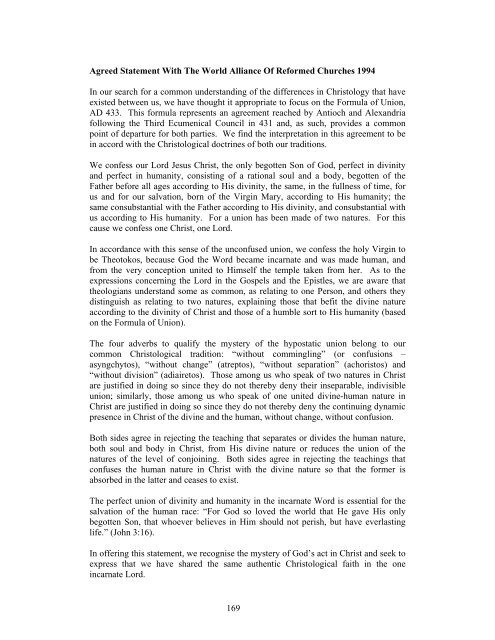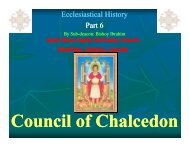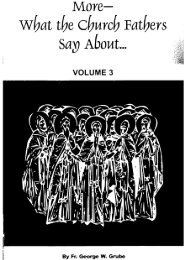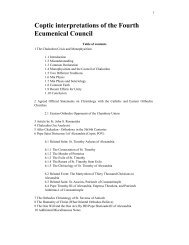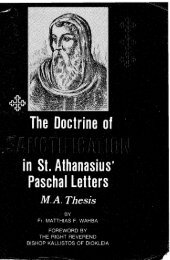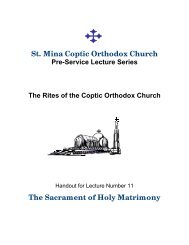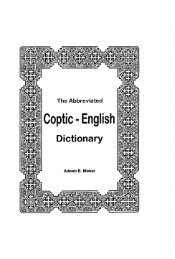Coptic Church & Ecumenical Movement - Saint Mina Coptic ...
Coptic Church & Ecumenical Movement - Saint Mina Coptic ...
Coptic Church & Ecumenical Movement - Saint Mina Coptic ...
Create successful ePaper yourself
Turn your PDF publications into a flip-book with our unique Google optimized e-Paper software.
Agreed Statement With The World Alliance Of Reformed <strong>Church</strong>es 1994<br />
In our search for a common understanding of the differences in Christology that have<br />
existed between us, we have thought it appropriate to focus on the Formula of Union,<br />
AD 433. This formula represents an agreement reached by Antioch and Alexandria<br />
following the Third <strong>Ecumenical</strong> Council in 431 and, as such, provides a common<br />
point of departure for both parties. We find the interpretation in this agreement to be<br />
in accord with the Christological doctrines of both our traditions.<br />
We confess our Lord Jesus Christ, the only begotten Son of God, perfect in divinity<br />
and perfect in humanity, consisting of a rational soul and a body, begotten of the<br />
Father before all ages according to His divinity, the same, in the fullness of time, for<br />
us and for our salvation, born of the Virgin Mary, according to His humanity; the<br />
same consubstantial with the Father according to His divinity, and consubstantial with<br />
us according to His humanity. For a union has been made of two natures. For this<br />
cause we confess one Christ, one Lord.<br />
In accordance with this sense of the unconfused union, we confess the holy Virgin to<br />
be Theotokos, because God the Word became incarnate and was made human, and<br />
from the very conception united to Himself the temple taken from her. As to the<br />
expressions concerning the Lord in the Gospels and the Epistles, we are aware that<br />
theologians understand some as common, as relating to one Person, and others they<br />
distinguish as relating to two natures, explaining those that befit the divine nature<br />
according to the divinity of Christ and those of a humble sort to His humanity (based<br />
on the Formula of Union).<br />
The four adverbs to qualify the mystery of the hypostatic union belong to our<br />
common Christological tradition: “without commingling” (or confusions –<br />
asyngchytos), “without change” (atreptos), “without separation” (achoristos) and<br />
“without division” (adiairetos). Those among us who speak of two natures in Christ<br />
are justified in doing so since they do not thereby deny their inseparable, indivisible<br />
union; similarly, those among us who speak of one united divine-human nature in<br />
Christ are justified in doing so since they do not thereby deny the continuing dynamic<br />
presence in Christ of the divine and the human, without change, without confusion.<br />
Both sides agree in rejecting the teaching that separates or divides the human nature,<br />
both soul and body in Christ, from His divine nature or reduces the union of the<br />
natures of the level of conjoining. Both sides agree in rejecting the teachings that<br />
confuses the human nature in Christ with the divine nature so that the former is<br />
absorbed in the latter and ceases to exist.<br />
The perfect union of divinity and humanity in the incarnate Word is essential for the<br />
salvation of the human race: “For God so loved the world that He gave His only<br />
begotten Son, that whoever believes in Him should not perish, but have everlasting<br />
life.” (John 3:16).<br />
In offering this statement, we recognise the mystery of God’s act in Christ and seek to<br />
express that we have shared the same authentic Christological faith in the one<br />
incarnate Lord.<br />
169


